Have you ever felt like your legs betrayed you halfway through a jog? Or maybe you've experienced that tightness in the back of your thighs when trying to touch your toes? Your hamstrings might be crying out for attention. Let's dive into everything you need to know about strengthening those crucial muscles on the back of your legs.
What Are Hamstrings (And Why Should You Care)?
Hamstring muscles are located at the back of your thigh. It consists of three muscles with names that might sound like dinosaur species: biceps femoris, semitendinosus, and semimembranosus. Don't worry—there won't be a quiz on these names later.
While quadriceps (front thigh muscles) often get all the glory, hamstring exercises are absolutely essential for:
- Running faster (imagine trying to sprint with weak hamstrings—hello, penguin waddle)
- Jumping higher (weak hamstrings = weak hops)
- Maintaining good posture (your mom was right about standing up straight)
- Preventing those embarrassing mid-game pulls and tears
Have a friend who pulled his hamstring trying to show off at the company picnic softball game? Let's make sure that's not you.
Benefits of Making Hamstring Exercises Part of Your Routine
Before diving into the ‘how,’ let's talk about the ‘why’. Want to build your leg endurance too? Try these effective wall sit practices. Hamstring strengthening exercises offer benefits that extend far beyond just making the back of your legs look good in shorts:
1. Better Balance Between Front and Back
Many people have overdeveloped quads and underdeveloped hamstrings—like having a car with amazing acceleration but terrible brakes. Hamstring muscles exercises help restore balance, reducing the risk of knee problems.
2. Turbocharge Your Speed
Ever notice how sprinters have well-developed backs of their legs? That's because hamstring muscles are crucial for generating power when you run. Even if your sprinting days consist of rushing to catch the closing elevator door, strong hamstrings help.
3. Injury-Proof Your Lower Body
Weak hamstrings are like having a weak link in a chain—they're often the first to give under pressure. Regular best hamstring workouts dramatically reduce your risk of pulls, tears, and even ACL injuries (those knee injuries that can sideline athletes for months).
4. Improve Your Everyday Movements
From bending down to pick up something you dropped to climbing stairs, strong hamstrings make daily activities easier. They're the muscles working behind the scenes of almost every lower body movement.
5. Better Athletic Performance
Whether you're playing weekend pickup basketball or chasing your toddler around the park, strong hamstrings improve your ability to change direction quickly, jump, and maintain balance.
Let's Get Started – Hamstring Exercises for Beginners
Here are some beginner-friendly hamstring exercises that you can do at home or in the gym. Remember, form matters more than weight or reps—focus on doing these correctly before adding more challenge.
Beginner-Friendly Home Exercises
1. Glute Bridges
This exercise works your hamstrings and glutes together (two for the price of one).
Steps:
- Lie on your back with knees bent and feet flat on the floor, hip-width apart.
- Keep arms at your sides with palms facing down
- Squeeze your glutes and hamstrings to lift your hips toward the ceiling
- Pause at the top when your body forms a straight line from shoulders to knees
- Lower back down slowly and repeat
Sets and reps for beginners: 2-3 sets of 5-10 repetitions
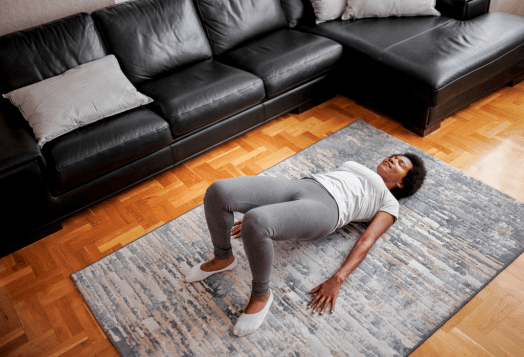
2. Single-Leg Hip Lifts
Once regular glute bridges become too easy, try this challenging variation.
Steps:
- Start in the same position as a glute bridge
- Extend one leg straight out
- Push through the heel of your grounded foot to lift your hips
- Keep your extended leg aligned with your torso
- Lower slowly and repeat
Tip: If this exercise makes your hamstring feel like it's sending a distress signal to NASA, you're probably doing it right.
Sets and reps for beginners: 2 sets of 5-10 reps per leg
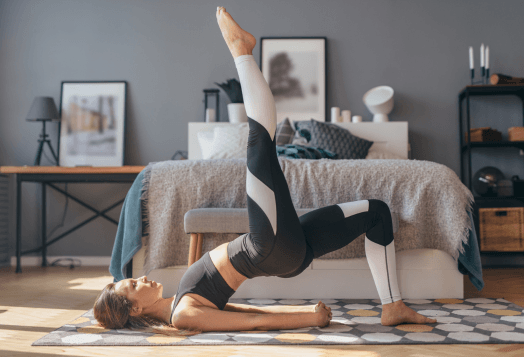
3. Plank Walkouts
This exercise might make you look like you're doing a strange dance move, but it's incredibly effective.
Steps:
- Stand with feet hip-width apart
- Keeping legs straight (or slightly bent if needed), hinge at the hips, and place hands on the floor
- Slowly walk your hands forward until you're in a plank position
- Walk your feet toward your hands while keeping your legs as straight as possible
- Return to standing and repeat
Sets and reps for beginners: 2 sets of 5-8 walkouts
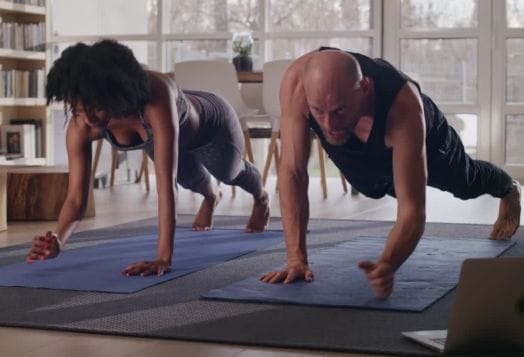
Hamstring Exercises Gym Edition
When you're ready to take your hamstring strengthening exercises to the next level, the gym offers equipment that can really target these muscles effectively.
1. Seated Leg Curls
This machine is like the hamstring equivalent of bicep curls.
Steps:
- Adjust the machine so your knees align with the pivot point
- Position the pad just above your heels
- Grasp the handles for stability
- Curl your legs back as far as comfortable
- Return to the starting position slowly—don't let the weight stack drop.
Sets and reps for beginners: 3 sets of 12-15 reps
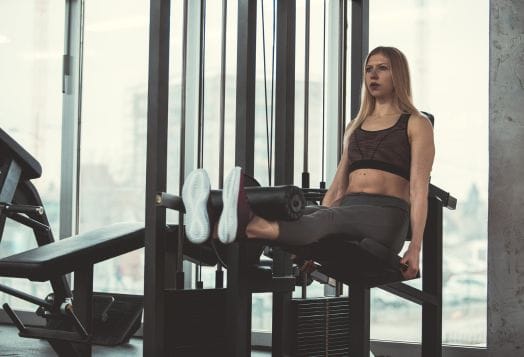
2. Romanian Deadlifts (Light Version)
Don't let the name intimidate you—this is one of the best hamstring workouts for beginners when done with light weight.
Steps:
- Stand holding light dumbbells in front of your thighs
- Keep a soft bend in your knees (not locked)
- Hinge at your hips, pushing your butt backward
- Lower the weights while keeping them close to your legs
- Stop when you feel a stretch in your hamstrings (usually at mid-shin)
- Squeeze your hamstrings to return to standing
Sets and reps for beginners: 3 sets of 10-12 reps with light weight

3. Swiss Ball Leg Curls
This exercise looks deceptively simple, but it will have your hamstring muscles talking to you the next day.
Steps:
- Lie on your back with heels on a stability ball
- Raise your hips so your body forms a straight line
- Pull the ball toward your butt by bending your knees
- Slowly straighten your legs to push the ball back
- Keep your hips elevated throughout the movement
- (If you've never done these before, prepare for your legs to shake like you're auditioning for a jello commercial.)
Sets and reps for beginners: 2 sets of 8-10 reps
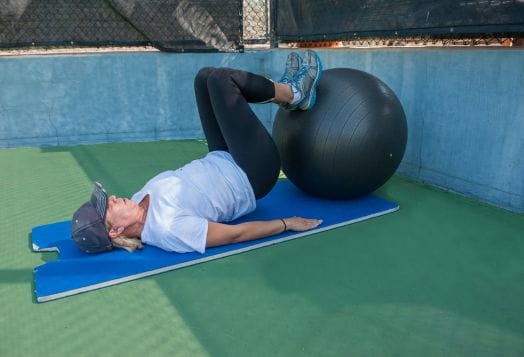
Advanced Glute and Hamstring Exercises
Once you've mastered the basics, these more challenging movements will enhance your hamstring strength. Looking for expert guidance on perfecting your form? Explore our certified fitness trainers on Pyng.
1. Single-Leg Romanian Deadlifts
This exercise improves both strength and balance—like trying to stand on one foot while touching your toes, but more structured.
Steps:
- Stand holding a light weight in one hand
- Shift your weight to one leg
- Hinge at the hips while extending the other leg behind you
- Lower the weight toward the floor
- Return to standing by squeezing your hamstring and glute
Sets and reps for beginners: 2 sets of 8-10 reps per leg
2. Good Mornings
Despite the cheerful name, this exercise provides a serious hamstring muscle workout.
Steps:
- Stand with feet shoulder-width apart
- Place your hands behind your head or a light barbell across your shoulders
- Hinge at the hips, keeping back flat
- Lower until you feel a stretch in your hamstrings
- Return to standing by squeezing your hamstrings and glutes
Sets and reps for beginners: 2-3 sets of 10-12 reps
How to Incorporate Hamstring Exercises Into Your Gym Routine
Wondering how to fit hamstring exercises into your existing workout schedule? Here's a practical guide to make it happen:
- For beginners: Train hamstrings 2 times per week.
- For intermediate fitness enthusiasts: 2 dedicated hamstring sessions weekly
- For advanced athletes: Up to 3 sessions per week with varied intensity
Remember that your hamstrings are also working during many compound movements like squats, lunges, and step-ups—so they're getting some work even on days you're not directly targeting them.
Common Mistakes to Avoid
Even the best hamstring workouts can be ineffective if you're making these common errors:
1. Using Your Back Instead of Your Hamstrings
Many beginners end up arching their lower back instead of hinging at the hips. Imagine your hips as a door hinge—the movement should happen there, not in your spine.
2. Rushing Through the Negative Phase
Lowering the weight too quickly is like skipping half the exercise. Control the descent to build more strength and prevent injury.
3. Not Going Through Full Range of Motion
Partial movements = partial results. Make sure you're feeling that hamstring stretch and contraction through the entire exercise.
4. Skipping the Warm-Up
Cold hamstrings are like cold rubber bands—they don't stretch well and might snap. A 5-minute cardio warm-up and light dynamic stretching can prevent painful regrets.
When Will You See Results?
Consistency is key with hamstring muscle exercises. You might feel stronger after just 2-3 weeks, but visible changes typically take 6-8 weeks of regular training. Remember that progress isn't always linear—some weeks you'll feel stronger than others, and that's completely normal.
Time to Put Those Hamstrings to Work
Strong hamstrings aren't just for athletes—they're for anyone who wants to move better, reduce injury risk, and improve overall lower body function. By incorporating these glute and hamstring exercises into your routine just twice a week, you'll build a foundation of strength that supports everything from daily activities to more advanced fitness goals.
Remember, the journey to stronger hamstrings isn't a sprint—it's more like a controlled Romanian deadlift: steady, focused, and with proper form.




